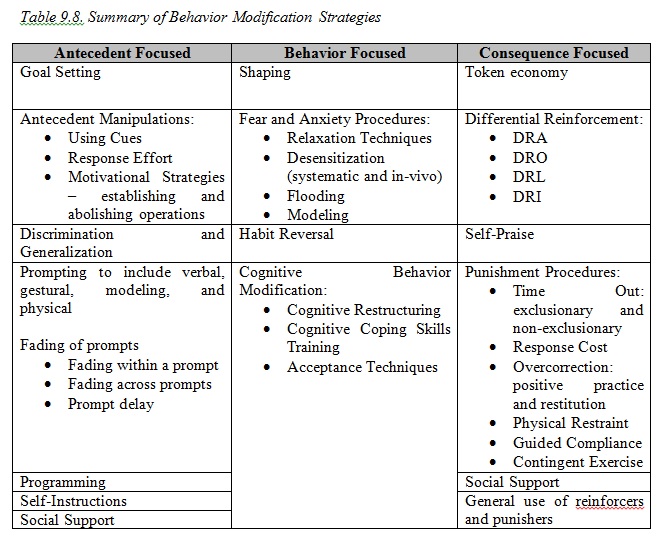Module 9: Advanced Operant Conditioning Procedures: Consequence Focused
Module Overview
Over the past two modules we have discussed strategies and principles that relate to the antecedent and the behavior itself. In this module, we turn our attention to the last part of the ABCs of behavior, and specifically, the consequence. Our discussion will cover reinforcers, differential reinforcement, the token economy, self-praise, and punishment. We will also turn our attention back to social support and how it relates to the aforementioned strategies covered in this module.
Module Outline
- 9.1. Reinforcer Selection
- 9.2. Differential Reinforcement
- 9.3. The Token Economy
- 9.4. Self-Praise
- 9.5. Aversive Control – Punishment
- 9.6. Social Support…Again
- 9.7. Planning Sheet 5: Selecting Reinforcers and Designing a Token Economy
- 9.8. Exercises
Module Learning Outcomes
- Clarify how to select reinforcers to use in a treatment plan.
- Clarify how to use differential reinforcement in a treatment plan.
- Describe and exemplify the use of the token economy in a treatment plan.
- Explain the role of self-praise in behavior modification.
- List, describe, and exemplify punishment procedures.
- State the role of social support in reinforcing a desirable behavior or punishing a problem/undesirable behavior.
- Complete Planning Sheet 5: Selecting Reinforcers and Designing a Token Economy
- Apply what you have learned in this module in Exercise 9.1.
9.1. Reinforcer Selection
Section Learning Objectives
- List and exemplify types of reinforcers.
- Clarify how we might figure out what reinforcer to use for a client.
- Clarify how we might figure out what reinforcer to use in our self-modification plan.
- Describe issues relevant to reinforcer selection.
9.1.1. What Can We Use as a Reinforcer?
All reinforcers are created equal. I mean, who doesn’t love video games, right? WRONG. What works for me may not work for you. Remember when we talked about increasing the effectiveness of reinforcers and punishers in Module 6.2.3. One of the five factors that was mentioned was individual differences or diversity/variability. This means that you need to find a reinforcer that will be important to the individual or yourself, and therefore motivate you to want to make the desirable behavior. With my son, offering to buy him a new book or take him to the movies would not work. He loves racing simulators and so to encourage him to practice better time management, I would offer him some additional time on his game and/or the ability to earn the money to buy the newest version of his favorite NASCAR game, or Madden.
What is a reinforcer? This is anything that makes a behavior more likely to occur in the future. In Module 6, we learned that reinforcers can be positive or negative. A positive reinforcer is giving something good that makes a behavior more likely to occur in the future while a negative reinforcer is when an aversive stimulus is taken away making a behavior more likely in the future. Reinforcers can take the form of:
- Consumables – or anything you can eat or drink such as candy, pizza, tacos, soda, tea, or alcohol
- Activities – engaging in pleasurable tasks such as skiing, bowling, going to the movies, hiking, playing football
- Tangibles – these can be gifts, a star on the board, a grab bag with toys in it, a new book, or a video game
- Privileges – these include tv or video game time, an extended curfew, time to work on a special project, time to drive the car, earning allowance for doing chores, getting out of doing homework
The choices are almost endless, making this seemingly easy task daunting. So how do we narrow it down?
9.1.2. How Do We Figure Out What to Use?
To figure out what reinforcers will work for a client, you could simply ask them what they like. If it is extra tv time, a favorite food, going out with friends, new baseball gear, buying a book, going to a party, or spending time on Facebook, then so be it. But maybe asking them is not possible. In this case, you could observe them while conducting the functional assessment, looking to see what they derive pleasure from. You could also use the reinforcer maintaining an undesirable behavior. They already like it and hence why this behavior persists, so use the reinforcer with the desirable behavior instead. If the child acts out to get attention, give him or her attention when the correct behavior occurs. Another strategy is to simply present several reinforcers to the person and see which one(s) are liked the most. This is called a preference assessment.
If we are selecting reinforcers to use in our own treatment plan, you can figure out what to use by asking yourself what your interests and hobbies are, what you do for fun or to relax, what makes you feel good, whether praise works with you and if so what type, how you would spend $100 if you had it, and what you would want as a present should someone give you one right now.
Again, it is imperative that you give this careful thought.
9.1.3. Issues to Consider When Selecting Reinforcers
It is imperative that you find reinforcers that are going to reinforce your desirable behavior. If they have no real value to you, or they are valued but you can get them whenever you want, you need to select again. Remember, that you need to have a contingency such that the reinforcer only occurs when some amount of your desired behavior occurs, based on your behavioral definition.
Be careful in selecting reinforcers that involve another person once received, such as the activity of going bowling with your boyfriend or girlfriend. If you make the desired behavior as specified and receive the bowling activity, then all is good. But if you don’t, you are not the only one affected. The benefit of including another person in your reinforcement is that he or she can exert pressure on you to make the desired behavior. I guess in this case it is a win-win. You make the desire behavior and you get to go on a date with your special someone.
Feel free to select more than one reinforcer too. You can pair secondary reinforcers with primary reinforcers such that you give praise (secondary) and then follow it with ice cream (primary); great for kids who just brought home an excellent report card. Using more than one reinforcer allows you to rotate them too so that the person does not become bored with receiving the same reinforcer over and over again.
Remember the principle of immediacy from Module 6.2.3 or reinforcing as soon as the desired behavior occurs. This may not always be practical but with habit or anxiety and fear producing behaviors, immediacy is a necessity. If you are trying to reduce a tic behavior, and the person uses their competing response/incompatible behavior which successfully stops the tic, an immediate reward is in order. They can deliver their own reinforcer too, but support from others is vital here too. If a child is afraid of dogs but uses relaxation techniques and desensitization procedures, and walks up to and pets the neighbor’s dog, a reinforcer should be delivered.
Consistency is key. The more consistent parents, teachers, significant others, etc. are in delivering reinforcers, the more consistent the person will be in making the desired/target behavior.
Final point. If a consumable, activity, privilege, or tangible is given and no increase in behavior occurs, then technically this “thing” is not a reinforcer.
9.2. Differential Reinforcement
Section Learning Objectives
- Define and exemplify differential reinforcement.
- List and describe the four differential reinforcement procedures.
- State reasons why differential reinforcement may not be working.
9.2.1. Defining Terms
In Module 6, we discussed the case in which a child is acting out and the parent gives her what she demands. When this occurs, the parent has reinforced a bad behavior (a PR) and the tantrum ending reinforces the parent caving into the demand (NR). Now both parties will respond the same way when in the same situation (child sees a toy which is her antecedent to act out and the screaming child is the stimulus/antecedent for the parent to give the girl the toy). If the same reinforcers occur again, the behavior will persist. Most people near the interaction likely desire a different outcome. Some will want the parent to discipline the girl, but others might handle the situation more like this. These individuals will let the child have her tantrum and just ignore her. After a bit, the child should calm down and once in a more pleasant state of mind, ask the parent for the toy. The parent will praise the child for acting more mature and agree to purchase the toy, so long as the good behavior continues. This is an example of differential reinforcement in which we attempt to get rid of undesirable or problem behaviors by using the positive reinforcement of desirable behaviors. Hence, both reinforcement and extinction are occurring, the former in terms of the desired behavior and the latter in terms of the undesirable or problem behavior. Differential reinforcement does not utilize punishment but is a positive approach to reward people for behaving in the desired manner.
9.2.2. Types of Differential Reinforcement
Differential reinforcement takes on many different forms as described below:
- DRA or Differential Reinforcement of Alternative Behavior – This is when we reinforce the desired behavior and do not reinforce undesirable behavior. Hence, the desired behavior increases and the undesirable behavior decreases to the point of extinction. The main goal of DRA is to increase a desired behavior and extinguish an undesirable behavior such as a student who frequently talks out of turn. The teacher praises the child in front of the class when he raises his hand and waits to be called on and does not do anything if he talks out of turn. Though this may be a bit disruptive at first, if the functional assessment reveals that the reinforcer for talking out of turn is the attention the teacher gives, not responding to the child will take away his reinforcer. This strategy allows us to use the reinforcer for the problem behavior with the desirable behavior. Eventually, the child will stop talking out of turn making the problem behavior extinct.
- DRO or Differential Reinforcement of Other Behavior – What if we instead need to eliminate a problem behavior – i.e. reducing it down to no occurrences? DRO is the strategy when we deliver a reinforcer contingent on the absence of an undesirable behavior for some period. We will need to identify the reinforcer for the problem behavior and then pick one to use when this behavior does not occur. Determine how long the person must go without making the undesirable behavior and obtain a stopwatch to track the time. Do not reinforce the problem behavior and only reinforce the absence of it using whatever reinforcer was selected, and if it is gone for the full-time interval. If the problem behavior occurs during this time, the countdown resets. Eventually the person will stop making the undesirable behavior and when this occurs, increase the interval length so that the procedure can be removed. If a child squirms in his seat, the teacher might tell him if he sits still for 5 minutes he will receive praise and a star to put on the star chart to be cashed in at a later time (this is a token economy described in the next section). If he moves before the 5 minutes is up, he has to start over, but if he is doing well, then the interval will change to 10 minutes, then 20 minutes, then 30, then 45, and eventually 60 or more. At that point, the child is sitting still on his own and the behavior is not contingent on receiving the reinforcer. What I just described is how to use a DRO procedure and then how to get rid of it which will be critical in the maintenance phase.
- DRL or Differential Reinforcement of Low Rates of Responding – There are times when we don’t necessarily want to completely stop a behavior, or take it to extinction, but reduce the occurrence of a behavior. Maybe we are the type of person who really enjoys fast food and eat it daily. This is of course not healthy, but we also don’t want to go cold turkey on it. We could use DRL and decide on how many times each week we will allow ourselves to visit a fast food chain. Instead of 7 times we decide that 3 is okay. If we use full session DRL we might say we cannot exceed four times going to McDonalds in a week (defined as Mon – Sun). If we eat at McDonalds, Burger King, Wendy’s, etc. four times on Monday but do not go again the rest of the week we are fine. Full session simply means you do not exceed the allowable number of behaviors during the specified time period. Eating fast food four times in a day is definitely not healthy, and to be candid, gross, so a better approach could be to use spaced DRL. Now we say that we can go to a fast food restaurant every other day. We could go on Monday, Wednesday, Friday, and Sunday. This works because we have not exceeded 4 behaviors in the specified time of one week.
- DRI or Differential Reinforcement of Incompatible Behavior – Now what if we have to substitute the behavior of a child such that he has to sit appropriately in his seat instead of walking around the room. Sitting is incompatible with walking around. DRI delivers a reinforcer when another behavior is used instead of the problem behavior. To say it another way, we reinforce behaviors that make the undesirable or problem behavior impossible to make. DRI is effective with habit behaviors such as thumb sucking. We reinforce the child keeping his hands in his pocket. Or what if a man tends to make disparaging remarks at drivers who cut him off or are driving too slowly (by his standard). This might be a bad model for his kids and so the man’s wife tells him to instead say something nice about the weather or hum a pleasant tune when he becomes frustrated with his fellow commuters. These alternative behaviors are incompatible with cursing and she rewards him with a kiss when he uses them.
Iit is important to keep in mind the following:
Table 9.1: Expected Outcome and Type of Differential Reinforcement to Use
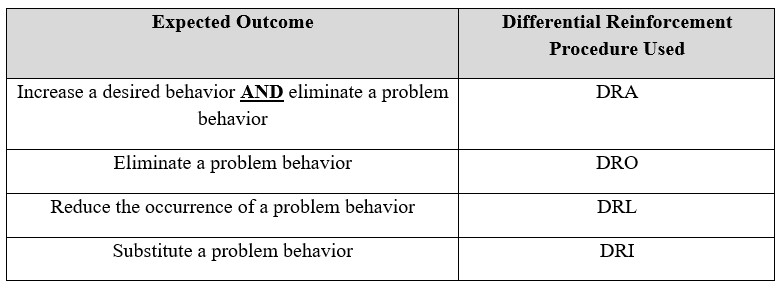
9.2.3. Why Differential Reinforcement May Not Be Working
Differential reinforcement may fail for a few different reasons. First, the reinforcers may not be reinforcing because they are not appealing to the individual, the person has to work too hard to obtain them, or the individual has become bored with them. Look at Section 9.1.3. for potential issues related to reinforcement selection. Second, the individual may not be able to make the alternative or desired behavior due to not being developmentally ready or the behavior being too complex. Third, the delivery of reinforcers was inconsistent, and the student felt that the agreement was reneged on. Fourth, generalization beyond the training situation did not occur. As you will see, once a treatment plan is in place, you will look at the data that has been collected and determine how your plan is going. It is at this time that you can make adjustments if any are needed. More on this when we get to Module 15.
9.3. The Token Economy
Section Learning Objectives
- Explain what a token economy is.
- Describe how a token economy is used.
- Develop a token economy for a hypothetical scenario.
9.3.1. Reinforcing Immediately
Recall that one of the factors affecting the effectiveness of reinforcers and punishers is delivering the consequence immediately. This means that if a parent wants to reinforce their child for studying hard and earning an ‘A’ on a math test, he or she needs to go to the school as soon as the child receives the grade and take him/her out for ice cream, no matter the disruption to the class. Alternatively, the parent can deliver praise to the child if going out is not practical, but that could cause embarrassment, especially if the child is in high school, and may become punishing instead. Anyway, the point is that immediacy is a nice concept, but not often practical. We cannot deliver the reinforcer or punisher right when the behavior occurs in most cases. So what do we do instead?
A solution is to use what is called a token economy. The basic premise is that the individual is provided with something that represents desired reinforcers and takes that “something” and cashes it in later for those reinforcers. You do not receive the reinforcer right away, but at a later time, and like shopping at Walmart, you use your tokens, the money, to purchase something you really want, the reinforcer.
9.3.2. Using a Token Economy – General Information and Applied to a Behavioral Deficit
To understand the token economy let’s answer the pivotal questions – who, what, when, where, why, and how, and address a few other issues.
9.3.2.1 Why. The token economy can be used at home by parents trying to get a child to complete chores, take a bath before playing video games, eat breakfast, behave well with siblings, or leave with enough time to get the bus or arrive at school before the bell rings. In the classroom, a teacher can use a token economy to encourage students to study hard, stay in their seat during quiet time, put away class materials, talk with an inside voice, behave on the playground, throw away their trash at lunch time, or to walk and not run through the halls. At work, an employer may wish to reward employees for working safely, going above and beyond by serving on committees, being on time, exceeding performance standards, or positively approach all aspects of their job. In a recovery center, nursing home, or prison setting, tokens may be awarded when patients take their medications or are compliant with the direction of staff members. Be sure you have precisely identified what the target behavior is through your behavior definition.
9.3.2.2. How. A token economy is a fun system that allows the person to earn up tokens and then cash them in for some type of reinforcer – whether a consumable, activity, privilege, or tangible. The tokens are accrued (and accumulated over time) once the target behavior occurs, as described clearly in the behavioral definition, and by themselves has no meaning. That said, it is fine to praise the person as they receive their tokens (a second PR, the first being the receipt of the tokens). Be clear on how many tokens are earned for engaging in the desired behavior(s).
Tokens gain meaning when they are associated with backup reinforcers or the regular reinforcers the person has in their life. This association occurs because the individual learns that he or she can take some number of tokens and cash them in for some amount of reinforcer. When we go to the store to purchase milk, we read the label and see that the gallon costs $3.29. We pick it up, go to the cashier, and when prompted, hand the cashier our money to complete the purchase. The token economy operates in the same exact fashion. How many tokens are needed to purchase a backup reinforcer is called the exchange rate.
9.3.2.3. Who. Since you are going to complete a self-modification project this term, who delivers the tokens can be yourself. Alternatively, you can have someone else deliver them such as a friend, significant other, parent, child, etc., if you feel that you might be too lenient with their awarding. In cases when you are trying to change the behavior of another person, anyone really can deliver the tokens and allow for the purchase of reinforcers. If in a school setting, the teacher likely is running the token economy and you probably have been in a few classrooms over time in which one was used. At home, parents will control the system and at work, your employer or immediate boss may use a token economy.
9.3.2.4. What. What can serve as a token? Bingo chips, stars on a chart, points, check marks, or poker chips can all be used, and it must be clear how many tokens are earned for engaging in a certain level of the behavior. Recall that operant conditioning includes the ability to not reward each occurrence of a behavior, but according to some schedule. We might reinforce a fixed or varying number of responses, or a fixed or varying amount of time. This concept can be used in a token economy and for the child in the classroom, we deliver 2 tokens every three times he raises his hand and waits to be called on (FR) or we deliver 3 tokens after some varying amount of time that the student sits calmly in his seat (VI).
9.3.2.5. Tokens table. Take a look at Table 9.2. The top portion shows how many tokens are earned for completing Behaviors, according to the behavior definition. If we make one full behavior, defined as completing 10 minutes of cardio, we earn 3 tokens. Also, notice that the table includes a token reward for not completing a full behavior of 10 minutes of cardio. This is useful in case you are unable to complete 30 minutes but do 25 minutes. Instead of awarding yourself 9 tokens for 30 minutes (3 tokens for each 10 minutes; you would have done 3, ten minute behaviors at 3 tokens each behavior for a total of 9 tokens – 3 behaviors x 3 tokens each = 9 tokens), you instead earn 7 tokens (you earned 6 tokens for the two full behaviors of 10 minutes each or a total of 20 minutes and then 1 token for the partial behavior of 5 minutes of cardio, totaling 7 tokens). If you had gone 23 minutes you would have only earned 6 tokens and no partial behavior since it is defined as 5 minutes of cardio.
The next set of rows are for Extra Points. Extra points are earned in addition to the points earned from “Behaviors.” Our plan calls for increasing how often we go to the gym each week and use a cardio machine. Notice that it is not duration that we are trying to increase, but frequency. Our goals stay fixed at 30 minutes and our number of days per week goes up from 2 to 5. Alternatively, another person may find that he or she goes to the gym regularly, but wants to increase how long workouts last (30 to 60 minutes), or how intense they are (low to high intensity). Two people may have the same target behavior but behaviorally define it much differently. Just keep this in mind. In our token economy, we can award extra points for completing each goal, and recall that we know when to move from one goal to the next based on our criterion. See Planning Sheet 3. You could also award a few extra tokens for meeting your daily goal (not a weekly goal) of working out 30 minutes. In our example, this is an additional 2 tokens and so if you worked out ay total of 30 minutes in one day, you would earn 9 tokens under Behaviors and another 2 tokens under Extra Points for a total of 11 tokens.
The final set of rows are under the header, Non-contingent Events. Tokens are given for simply finishing each week of the plan. They are not linked to any specific behaviors being completed. As such, these tokens are rewarded according to a fixed interval (FI) schedule and help to maintain focus in the event we have a bad week and do not earn many tokens, or are accumulating them for some costly back up reinforcer. If you completed your first week of the plan, you would be able to rent a movie. This positive reinforcer and privilege is not linked to, or conditional on, making any number of behaviors for the week. Hence, why it is called a non-contingent event. It is liked to time and nothing else. You should ideally include one reinforcer for each possible week of your plan. If you have four goals with a 2 week criterion, that would require 8 weeks of non-contingent event reinforcers. Of course, you might not achieve you goal one week during this time and need a 9th week. You could recycle one of the previous reinforcers or create a new one. For your plan though, assume success each week and create 8 reinforcers linked to the 8 weeks of the treatment plan.
Table 9.2: Sample Behaviors & Token Values for Exercise Behavior (Deficit)
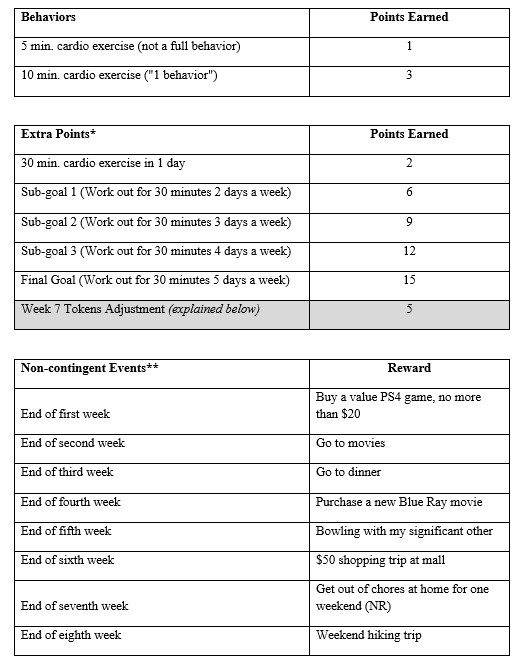
So before moving on, let’s make sure this is clear. You are in Week 4 of your plan and worked out a total of 3 days that week, and 30 minutes each day. All previous weeks have been a success and you already achieved Sub-goal 1. You would earn the following:
- 27 tokens under Behaviors (9 tokens a day x 3 days = 27 tokens)
- 6 tokens under Extra Points for the daily goals (2 tokens for 30 min. of cardio in one day x 3 days)
- 9 tokens under Extra Points for completing Subgoal 2
- Blue Ray – Completing your fourth week
- TOTAL – 42 tokens (27+6+9) and 1 blue ray
9.3.2.6. Calculating max tokens during your plan. Now you will want to figure out what the max tokens are you can earn for each day, week, and the whole treatment phase. Why do you want to know what the max tokens are earned each week, and for the whole entire treatment phase? This will help you set the prices for your back up reinforcers which fall on Table 2 (coming up in a bit). Also, it is a way to make sure the number of tokens earned actually increase across weeks. Otherwise, your graph at the end will look odd, with at least one dip in the line. This usually indicates goal failure but in this case, it is not what is going on.
For our current example, you can earn the following max points. Assume success each week and a two-week criterion. See the discussion of how to calculate each day above if you are unclear how the weekly counts were arrived at. The basic calculations are in parentheses.
- Week 1 – Earn 22 tokens (18+4) and PS4 game (NCE 1)
- Week 2 – Earn 28 tokens (18+4+6) and movies (NCE 2)
- Week 3 – Earn 33 tokens (27+6) and dinner (NCE 3)
- Week 4 – Earn 42 tokens (27+6+9) and Blue Ray (NCE 4)
- Week 5 – Earn 44 tokens (36+8) and bowling (NCE 5)
- Week 6 – Earn 56 tokens (36+8+12) and shopping trip (NCE 6)
- Week 7 – Earn 55 tokens (45+10) and chores (NCE 7)
- Week 8 – Earn 70 tokens (45+10+15) and hiking trip (NCE 8)
- Maintenance Phase
- TOTAL TOKENS TO BE EARNED – 350 (assumes just 8 weeks of treatment – no weekly failures resulting in additional weeks at the current goal level)
Notice that from Week 6 to Week 7 your number of tokens drops by 1. This is not a failure, but a product of how the token economy was designed. In the Discussion section of your paper you will describe why this has occurred. You could, instead, choose to add 5 additional tokens to the Week 7 count so that it is 60 instead of 55 and shows an upward progression from Week 6. The total of 60 is under the max earned in Week 8 of 70 so it makes sense. You could just call this Week 7 Tokens Adjustment under Extra Points and set it to 5 tokens. Note that your total number earned would go up to 355.
So the adjusted numbers would be:
- Week 1 – Earn 22 tokens (18+4) and PS4 game (NCE 1)
- Week 2 – Earn 28 tokens (18+4+6) and movies (NCE 2)
- Week 3 – Earn 33 tokens (27+6) and dinner (NCE 3)
- Week 4 – Earn 42 tokens (27+6+9) and Blue Ray (NCE 4)
- Week 5 – Earn 44 tokens (36+8) and bowling (NCE 5)
- Week 6 – Earn 56 tokens (36+8+12) and shopping trip (NCE 6)
- Week 7 – Earn 60 tokens (45+10+5) and chores (NCE 7)
- Week 8 – Earn 70 tokens (45+10+15) and hiking trip (NCE 8)
- Maintenance Phase
- TOTAL TOKENS TO BE EARNED – 355 (assumes just 8 weeks of treatment – no weekly failures resulting in additional weeks at the current goal level)
9.3.2.7. Backup reinforcers table. As for backup reinforcers, use the strategies mentioned in Module 6 to discover what works for an individual but if in a group setting, use general reinforcers that most will like such as toys and candy in a classroom, gift cards or time off at work, and additional tv time or exercise time at a prison or recovery center. It is good to use multiple backup reinforcers and different costs. Going to the movies is not the same as having 15 extra minutes of Netflix. The former should cost more than the latter. A few expensive and prized backup reinforcers are good too, such as the child purchasing the Nintendo Switch for 1,000 tokens and encourages him or her to work hard and accumulate tokens over time. But again, have some low cost back up reinforcers that the child can use some of the tokens on for more immediate reinforcers and it is okay to reward simply based on time, and not behavior. You might decide that at the end of the first week of the plan you will take the child to the movies. This provides reinforcement without having to cash in tokens. Just make sure movies are not in the list of back up reinforcers that tokens are exchanged for.
Table 9.3 shows 9 backup reinforcers and their cost. Notice that the reinforcers are listed from least to most expensive. The cost in tokens is proportionate to the actual cost of the backup reinforcer. Hence, going to the movies should not cost less tokens then a song download.
Table 9.3: Sample Back-up Reinforcers & Costs for Exercise Behavior (Deficit)
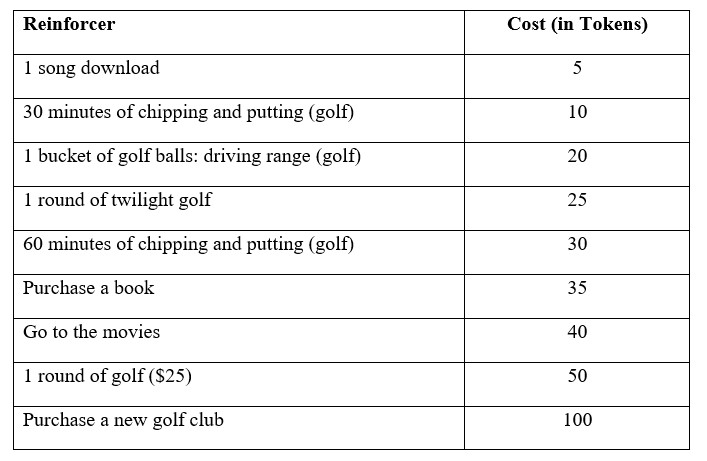
As noted before, variety is the spice of life. Have a lot of reinforcers to choose from and select ones that you will be excited about earning and partaking in. Do not simply select a reinforcer to have something down on paper. Carefully consider what you will use as backup reinforcers. This is quite possibly the most difficult aspect of the token economy and your behavior modification plan in general. Once you purchase a backup reinforcer deduct the amount from the tokens you have accrued so far and place it in a bank of sorts or at least record the purchase for review later. Some of your backup reinforcers will be one-time deals. You don’t need to purchase golf clubs more than once, but you may want to download multiple songs. You may also decide to golf on multiple occasions. Going back to our example, we earned 42 tokens for the week and so could purchase a song download, 30 minutes of chipping and putting, 1 bucket of golf balls at the driving range, or 1 round of twilight golf. We could also purchase a combination of these reinforcers or elect to purchase none at all and save up for the new golf club. The choice is ours to make and is the same as saving up the money earned on our paycheck for some item.
You also want to know what the maximum number of tokens you could earn during your plan to ensure that you earn enough to purchase all of your backup reinforcers at least once. Recall that in our example, the max tokens earned were 355 after the Week 7 adjustment. If you add up the backup reinforcer costs from Table 9.3 you will find that the entire list costs 315 tokens. Hence, you could purchase each backup reinforcer once, and a few of the cheaper ones more often. The token economy is set up pretty sound.
9.3.2.8. When and where. Determine a time and place to cash in the tokens. It could be at the end of the day or the end of the week. If at home, the parent might allow a child to cash in tokens on Friday night at 7:00 pm. If at school, the teacher could allow students to cash in tokens at lunch to gain a little extra recess time (a PR) or at the end of the day to get out of some amount of homework (a NR). Make this determination of when and where in advance of starting any token economy. Be advised that the person may decide not to cash in tokens, but to accumulate them, and that is perfectly fine. Give them the opportunity to cash in tokens all the same.
9.3.2.9. Punishers too? It is possible within a token economy to include consequences if the person engages in the undesirable behavior. For instance, in a classroom, if a child gets out of his seat and disrupts the class during individual reading time, the teacher would not obviously award any tokens, but she could also take some away. Likewise, if a child plays video games before taking his shower, tokens can be lost. These punishers are called response costs. As tokens are taken, they could be earned back. The lost tokens are negative punishers (taking away something good – the tokens – to make a behavior less likely – the problem behavior), but the system could include a way to earn back all, or some, of the lost tokens, for exceptionally good behavior (called overcorrection in Module 9.5). If this occurs, we are delivering a NR (taking away something bad – the loss of the tokens – making a behavior more likely to occur – the desired behavior).
9.3.2.10. Establishing and ending a token economy. When first implementing a token economy it is prudent to use continuous reinforcement to encourage the person to make the desired behavior often and offer more tokens for the behavior. Set the exchange rate for back up reinforcers low too. These measures will help you to establish the system and get the person, or group, excited about it. Once the token economy is moving along smoothly, switch to a reinforcement schedule (FR, VR, FI, or VI) and feel free to change the schedule over time. The person should start making the desired behavior with more regularity and eventually it becomes a habit or the behavior he/she routinely makes. When that occurs, increasing the number of responses or time in between reinforcement is needed to fade the token economy out. The person will rely less and less on the token economy to make the desired response and so its use is not as necessary.
9.3.2.11. Advantages. As noted, the token economy is a fun way to get “paid” for doing what is expected. It motivates the individual receiving the tokens to continue earning them, especially if you have some really attractive backup reinforcers that can be purchased. They are easy to give out and for the person to accumulate.
When determining if your treatment plan worked, you can of course count behaviors made across time, but you can also examine how many tokens were earned and graph this as well. In fact, you will use the table below to do this:
Table 9.4. Treatment Phase Token Log
Directions: Record the number of tokens earned each day of your treatment phase and then calculate weekly totals. You have been provided columns for up to 8 weeks on this table but other columns can be added as needed. Remember, for your course project, you are only required to record for three weeks. Feel free to continue your project beyond though.
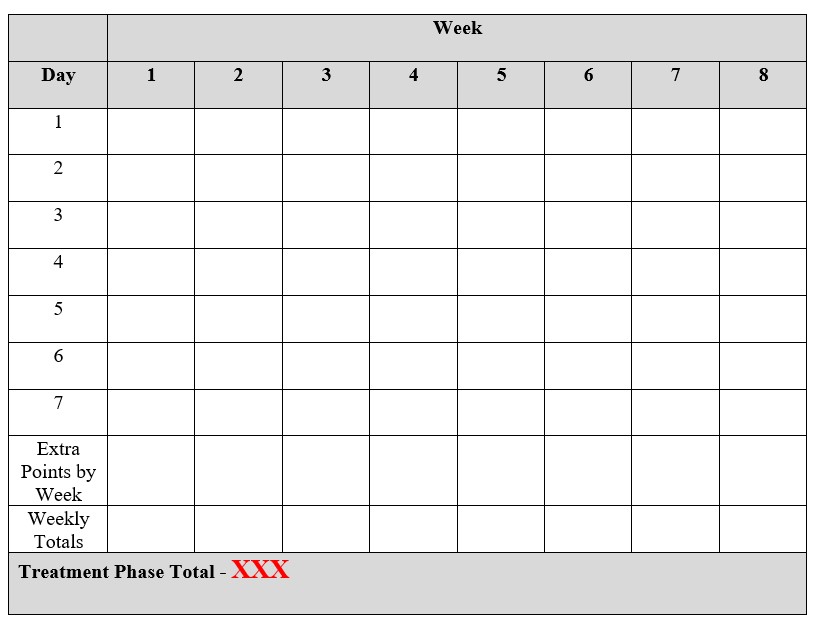
If your plan is successful, you should see an increase in tokens each week. Again, this is another way to demonstrate the success of your treatment strategies in making the desired change in behavior.
9.3.2.12. Disadvantages. It takes time and some degree of effort and organization to run the token economy. Good record keeping is a necessity, especially if using the information gained from it as an additional dependent variable. The backup reinforcers you use may be low or no cost, such as giving additional video game time (privilege) or allowing your child extra time to go throw the football around outside (activity), but others will cost money such as taking your child out for ice cream (a consumable) or giving a video game (a tangible). Be sure you have whatever backup reinforcers you will use ahead of time. When the person cashes in tokens, they should not have to wait for you to run to the store to purchase what they just requested. And some back up reinforcers could be costly, such as taking a trip or purchasing a new video game system or computer software.
9.3.3. Using a Token Economy with a Behavioral Excess
Not every project is a behavioral deficit. Some of you may have chosen a behavioral excess. Here is one way to approach this for the reduction in caloric intake example:
BEHAVIORAL DEFINITION – Eating 100 calories
GOALS
The goals may have been something like eat no more than 2000 calories a day (20 behaviors), 1800 calories (18 behaviors), 1500 calories (15 behaviors, and the distal goal of 1200 calories a day (12 behaviors). Weight loss is the goal and reducing your calories is the vehicle to achieve it. Normally, your token economy will focus on behaviors made but, in this case, a different approach will be appropriate. If you award tokens because you made a behavior, you would technically be awarding tokens for eating more calories which works against your underlying goal. Does that make sense? Think about it carefully. If you gave 5 tokens for each behavior, you would get 100 tokens when you eat 2000 calories and then go down from there (90, 75, and 60) which is technically punishing and will discourage your behavior. We need tokens to increase across time no matter the behavior (excess or deficit).
So try this in your token economy:
Table 9.5: Sample Behaviors & Token Values for Caloric Reduction Behavior (Excess)
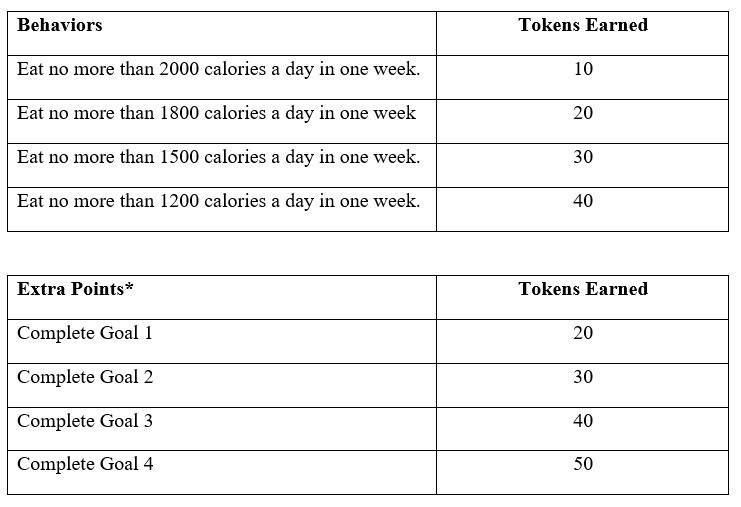
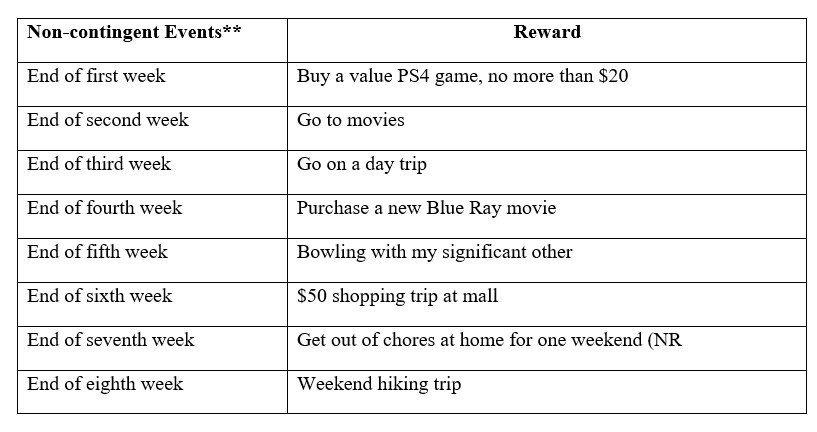
NOTICE that your tokens earned increase as your excess of calories goes down through the goals. You would also only earn behavior points based on the current subgoal you are working on. If you are at the 1500 calorie goal and achieve it, you only earn 30 tokens, not 30+20+10 (the goals above it).
You could include Extra Points for eating fruits and vegetables or making one positive food substitution at a meal (getting broccoli instead of fries). Beyond the completed goal points, the sky is the limit.
Here are the maximum tokens you can earn throughout the treatment phase (assume success each week and a 2 week criterion for each goal) using Table 9.4. This is what your table would look like if 100% successful each week.
Table 9.6. Max Tokens Log for Behavioral Excess Example
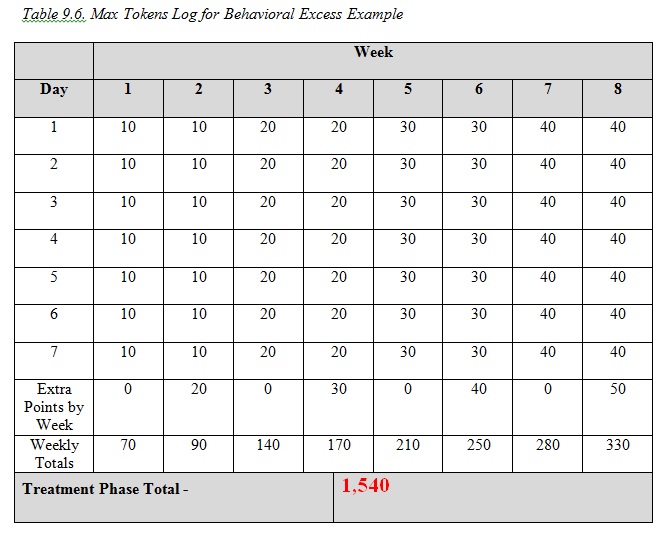
And the calculations:
- Week 1 – Earn 70 tokens (Beh 1 x 7 days) and PS4 game (NCE 1)
- Week 2 – Earn 90 tokens (Beh 1 x 7 days and EP 1) and movies (NCE 2)
- Week 3 – Earn 140 tokens (Beh 2 x 7 days) and dinner (NCE 3)
- Week 4 – Earn 170 tokens (Beh 2 x 7 days and EP 2) and Blue Ray (NCE 4)
- Week 5 – Earn 210 tokens (Beh 3 x 7 days) and bowling (NCE 5)
- Week 6 – Earn 250 tokens (Beh 3 x 7 days and EP 3) and shopping trip (NCE 6)
- Week 7 – Earn 280 tokens (Beh 4 x 7 days) and chores (NCE 7)
- Week 8 – Earn 330 tokens (Beh 4 x 7 days and EP 4) and hiking trip (NCE 8)
- Maintenance Phase
TOTAL TOKENS TO BE EARNED – 1,540 (assumes just 8 weeks of treatment – no weekly failures resulting in additional weeks at the current goal level)
Your tokens go up over time and with each week. You earn daily tokens (at the end of the day since you have to figure out what your total caloric intake is) and if you fall short one day, you can still earn tokens for the other days. Of course, if you did not meet your weekly goal you will have to stay at the current goal level according to your criterion but at least you did earn a few tokens for your success on the other days.
Now what about your back up reinforcers for the behavioral excess? Let’s use the same set of back up reinforcers from our deficit example and the same costs to make a point.
Table 9.7: Sample Back-up Reinforcers & Costs for Caloric Reduction Behavior (Excess)
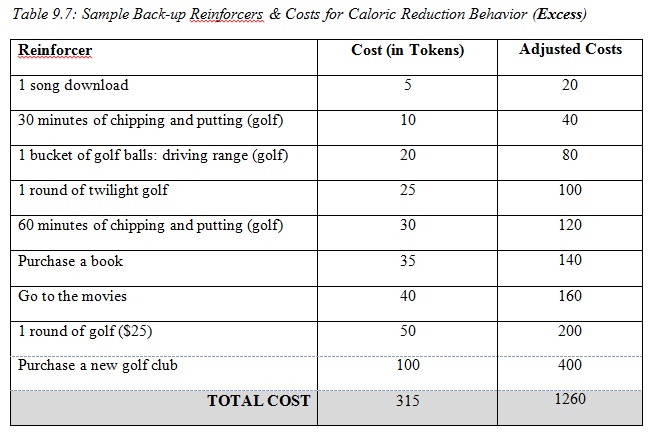
From our max tokens calculation, we know we can earn up to 1540 tokens. If we use the costs in tokens from the deficit example, which totals 315, we could purchase each back up reinforce in the table almost 5 times for a total cost of 1575. Obviously, our costs are set too low. If we still wanted to retain the same list of back up reinforcers a simple solution would be to multiple the current costs by 4. This brings our new back up reinforce cost to 1260 if we purchase them all which is 280 under the max tokens we can earn. Hence, this allows us to purchase a few of the reinforcers more than once. Be sure you make a clear comparison between the max tokens to be earned and total costs of your back up reinforcers and look for issues.
NOTE: Be sure to read over the preceding section carefully before moving on to
the practice exercise in Section 9.3.4.
9.3.4. Practice Using a Token Economy
Scenario:
You are conducting a remedial reading program with a group of 4 third graders who are reading behind grade level. You are using a standardized reading program in which the students identify words and word sounds, read short passages aloud, and answer comprehension questions. You sit in from of the students as you conduct the lesson, and the students have many opportunities to respond in each group session. The students tend to be distracted and pay attention to things in the room other than the instructional items that are being presented. Answering the questions given above, describe the token economy you will implement with these students. Be specific.
Why – Identify the desirable behaviors you want to strengthen or problem behaviors you want to extinguish (create your behavioral definitions)?
Who will deliver tokens and “sell” the backup reinforcers? This may not be the same person.
What – What tokens will you use?
What – What backup reinforcers will you use? Include consumables, activities, tangibles, and privileges. Select more than one and rank them in order of importance/cost.
How – How many tokens will you give for engaging in the desired behavior? Be clear and consider your schedule (intermittent or continuous).
How much will the backup reinforcers cost? In other words, what is their price or exchange rate?
It is useful to create tables for your token economy and in your self-management project, you will be required to do so. The two tables you should use are (see above for a detailed description):
- One for the behaviors and how many tokens they earn to include any extra points and non-contingent events.
- One for the backup reinforcers and how much they cost (exchange rate).
Complete the tables below. Use the space below to work out your thoughts on tokens and back up reinforcers before filling the tables.
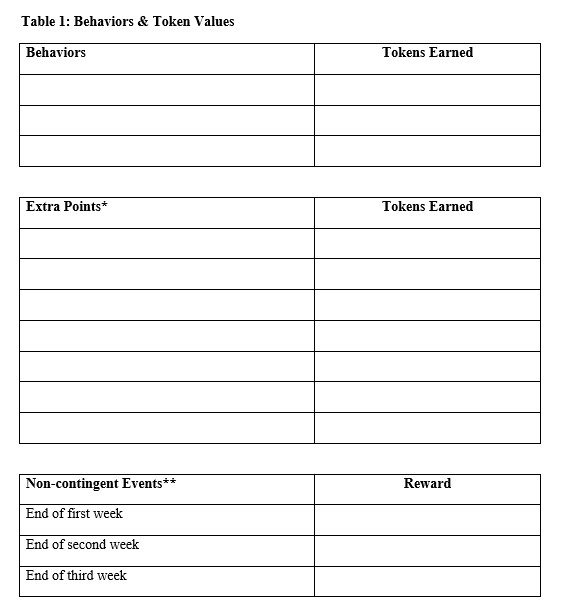
NOTE: For the purpose of this exercise, just cover up to three weeks for the non-contingent events as this matches your self-modification plan. But know that you can identify a reward for every week that your treatment plan runs, whether three or ten.
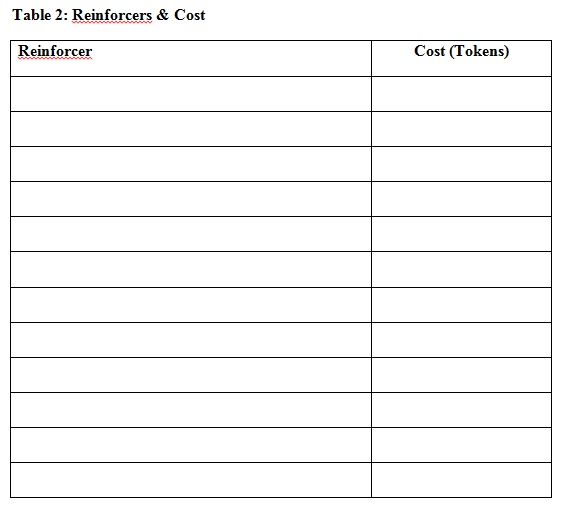
NOTE: You do not have to use all rows in Table 2 but you must have more than one backup reinforcer. Attempt to come up with 5 at a minimum and be sure they are of differing costs and different quality (low to high).
When and Where – When and where are the tokens exchanged for the backup reinforcers?
How will you use response costs? Be sure to define the problem behavior(s) and the cost of making those behaviors?
How will you terminate the token economy with the students?
Once you have finished, share your plan with the class. If in a physical classroom, your instructor will tell you how do this. If online, your instructor may have you share in a discussion board or submit as an assignment. Consult your syllabus for details.
9.4. Self-Praise
Section Learning Objectives
- Explain the importance of self-praise in self-modification.
Though we will not spend a lot of time on self-praise, that does not mean it is not as important as other strategies discussed in the past three modules. In fact, in some ways it is the most important but is also simple to employ. Self-praise is also called verbal self-reinforcement and is simply when you tell yourself, “Nice job” or “Way to go.” It can be said out loud or covertly and at times is left out of behavior medication plans because it seems silly to do or conceited, neither of which is true. Be sure to pat yourself on the back for a job well done.
9.5. Aversive Control – Punishment
Section Learning Objectives
- Outline the major aversive control procedures and provide an example for each.
- Assess the utility of punishment. Defend your position.
As you well know already there are two types of consequences – reinforcement, which we have spoken about quite a lot already, and punishment, which we have not discussed in much detail. Section 9.5 covers the control of behavior via punishments and several strategies will be discussed.
9.5.1. Time Outs
Probably the most well-known of all punishment procedures is the time out. Simply, a time out is when a person is removed from an activity because they are engaging in an undesirable or problem behavior. If effective, the time out should result in a reduction of the problem behavior in the future and so functions as a negative punishment (NP; taking away something good – the fun activity which serves as a reinforcement – making a behavior less likely in the future). The length of time needs to be determined and the person told how long he/she is expected to “sit this one out.” At the end of the time, if the problem behavior has not occurred, he or she can be released from the time out. This reinforces the good behavior by serving as a NR. If the behavior is occurring and the person released, you just reinforced the problem behavior by taking away the aversive time out. Be careful with implementing the time out procedure. Notice that an NR occurs in both cases. The aversive stimulus is the time out and is what is removed. But what behavior are you reinforcing? Proper use of a time out reinforcers the desirable behavior while misuse of the procedure reinforcers the problem behavior.
Time outs take two forms – exclusionary or non-exclusionary. Exclusionary time outs are when the person is removed from the actual location where the problem behavior is occurring. The best example, and the one you might be thinking of, is when a teacher sends a child to the principal’s office. Obviously then, a child is not removed from the situation in a non-exclusionary time out but cannot partake in the reinforcing activity. Depending on what the activity is, I might say that non-exclusionary is more punishing. Why is that? If a child misbehaves on the playground and the teacher makes him sit on the side, he still can see all the fun the other kids are having but cannot participate. This is worse than being sent inside to sit at a table or talk with the principal, and not being able to see and hear all the fun that is going on.
One major concern with the time out is the function of the problem behavior. Maybe the child is acting out so that he or she can get out of doing math work. When the teacher sends the child to the principal’s office, the punisher is actually not punishing, but reinforcing future acting out. Essentially, the acting out and being removed from the room is a NR – taking away something aversive (the math work) which makes a behavior (the acting out) more likely to occur in the future.
9.5.2. Response Costs
We discussed response costs once already near the end of our section on the token economy. Simply, a response cost is a type of negative punisher in which some amount of a reinforcer is removed when a problem/undesirable behavior is engaged in.
In a token economy – The reinforcer is the token. Let’s say you did not go to the gym. As such, you will not have the chance to earn tokens for going. It might be that you had a major test that day and used the gym time to squeeze in some additional studying. Do not punish this as it is an understandable compromise to make. But if you work up and instead played on your phone and lost the time to go, then a response cost is appropriate and you might take away 3 tokens (The loss of tokens should make the behavior of playing on the phone less likely to occur in the future, assuming you care about earning tokens and cashing them in from the start. This is why it is essential to have reinforcers that have meaning to you).
Outside of a token economy – If you are not using a token economy and engage in the same desired behavior as noted above, you could take away Netflix time later that day as a response cost. In this case, Netflix time is a PR and its loss makes playing on the phone less likely in the future.
Do not punish the “act” of not going to the gym but the undesirable behavior that was engaged in instead. You do not want the gym associated with anything negative (except maybe soreness but that is to be expected, and hey, no pain, no gain).
9.5.3. Overcorrection
Did you ever throw a tantrum and trash your room? Have you become so upset at someone that you yelled at them for a period of time? If so, you engaged in a problem behavior and likely were punished for doing so. If in the context of your childhood home, your parents may have made you clean your room up and make it look better than it did before, or be extra nice to your sibling. These are types of overcorrection procedures or when a person is expected to engage in effortful behavior for an extended period after the occurrence of an undesirable behavior. The example of cleaning the room is called restitution, or restoring the environment to a condition that is better than it was before the undesirable behavior, and being super nice is called positive practice, or engaging in the correct form of behavior over and over again.
9.5.4. Other forms of Punishment
In the military, it is quite common to have a soldier (and his whole company) who has not followed instructions or engaged in a behavior unbecoming a solider, to engage in push-ups, sit-ups, jogging in place, holding a rifle above the head, running extra laps around a track, etc. These forms of contingent exercise should decrease the problem behavior in the future (as will the heckling by the rest of the company after the exercise is over and the sergeant is gone).
Sometimes a person is engaging in self-injurious problem behavior and need to be physically restrained or held down. The restraint is not pleasant and results in the loss of voluntary control (taking away something good) which makes the behavior of hitting oneself in the head less likely to occur in the future (the person should remember the discomfort of being restrained and the loss of control).
And finally, I think we all have been in the situation of not listening to our parents and being picked up or walked into our room and shown how to clean it. This form of guided compliance, or physically guiding the person through the activity is aversive and in the future he or she should engage in the desire behavior to avoid the discomfort of being guided (avoidance behavior in the future; once you are doing the correct behavior in the present, the guidance compliance ends, which is NR and an escape behavior).
9.5.5 Does Punishment Work?
As with all things in life, the answer is yes…and no. In other words, there are pros and cons. Let’s explore them.
Pros of Punishment:
- Consistency is most important – If you punish each and every time the person engages in the undesirable or problem behavior, they will stop making the behavior (i.e. Speeding).
- It can be unquestionably effective – Punishment can deter some criminals from repeating their crimes.
- Avoidance training – Sometimes, after punishment has been administered a few times, it is not needed any more for the mere threat of it is enough to induce the desired behavior.
- Severity of punishment makes no difference – The mere fact of being punished is enough most times, not all.
Cons of Punishment:
- It is often administered inappropriately – In a blind rage, people often apply punishment broadly such that it covers all sorts of irrelevant behaviors. At times, parents take out their frustrations at work on their kids and what would not have upset them much one day, angers them immensely another.
- The recipient of the punishment often responds with anxiety, fear, or rage and these emotional side effects generalize to the entire situation. You can see this in animals when they have been punished for soiling the carpet and are disciplined.
- The effectiveness of punishment is often temporary, depending on the presence of the punishing person or circumstances. When the punisher is not there, the punished misbehaves again. This is captured in the cliché, “When the chiefs away the cat will play.”
- Most behavior is hard to punish immediately and during the delay behavior may be reinforced several times – i.e. not getting a speeding ticket every time you speed. Of course, in a token economy, the response cost can be delivered immediately as is the case with the reinforcer in the form of the token, but token economies are used in select situations.
- Punishment conveys little information – Does not tell the person how to act. If you want them to display desirable behavior, they have to know what it is.
- An action meant to punish may instead be reinforcing as when a child acts out for attention. For them it is a positive reinforcer. What about the case of the child acting out to get out of math work? In this case the behavior leads to a consequence and specifically negative reinforcement. The functional assessment should help you understand why the problem behavior occurs so this issue can be avoided.
So, what is the final verdict on punishment? The list of cons are much more extensive than the list of pros, and the first pro, consistency, is not practical most times leading to the fourth con. This might make us think that punishment is not useful. It can be if the following is practiced:
- Do not use physical abuse (takes care of Con 1 and 2).
- Tell the person how to behavior (takes care of Con 5).
- Reinforce the desired behavior when it occurs.
9.6. Social Support … Again
Section Learning Objectives
- Clarify the role of social support in the delivery of consequences for behavior.
And finally, we are back to social support, which was discussed as an antecedent strategy. If our friends and family can provide us reminders to engage in the correct behavior before we make it, they too can deliver reinforcers and punishers as consequences. Keep this in mind as social support works through the entire process of behavior modification.
9.7. Planning Sheet 5: Selecting Reinforcers and Designing a Token Economy
Section Learning Objectives
- Complete and submit Planning Sheet 5.
Before we move to the selection of strategies for our behavior modification plan, we should first consider what reinforcers we might use in this plan. Having a list now will make things easier later, and we can also design our token economy to include in the proposal.
Planning Sheet 5 can be found in Appendix 1: Self-Management Plan Documents, at the back of this book.
9.8. Exercises
Section Learning Objectives
- Complete the following exercises using what you have learned in this module.
Exercise 9.1: Strategies to Use with the Consequence
Directions: For the following, select the appropriate strategy or use the strategy that is indicated.
In questions 1-8, classify the following as DRA, DRO, DRL, or DRI. Why did you choose this strategy (i.e. what is the expected outcome)?
- Johnny squirms in his seat often during math class. His teacher decides to give him a sticker when he goes without fidgeting for 10 minutes.
- Mrs. Johnson decides to give each student who uses his inside voice in the classroom instead of yelling a sticker that he/she can use to purchase backup reinforcers at the designated time (a token economy is being used but focus on the type of differential reinforcement).
- A supervisor has an employee who frequently makes derogatory comments to his coworkers. He continues this because some employees laugh along with him. The supervisor decides to only reinforce the hostile employee when he says something positive and to ignore him when he says something negative.
- You are meeting with your study group but you have a genuine comedian who provides unending entertainment for all… so much so, you get nothing done. Your group decides to tell the funny member to limit jokes to no more than 5 during the entire session so that work can be finished.
- You are working with a friend to reduce your nail biting behavior. You replace nail biting with chewing gum and the friend reinforces you with a compliment whenever you chew gum in anxiety producing situations instead of biting your nails.
- Your child has misbehaved and so you tell him that if he does not act out again in the next 30 minutes, you will allow him to have one piece of candy. He acts out about 22 minutes in and so you reset the clock and make him start over.
- A student in class has a tendency to surf the internet while lecture is going on. Due to this, she has to ask the professor to repeat what was said so she can take notes. The professor decides to only answer her questions when she is paying attention and to ignore her hand when she is on the internet (assume the professor can see when the student is online).
- A parent rewards a child for limiting the number of questions that are asked when driving to school from 8 to 4.
—————————————————————————————————————————————————————————————————-
9. A teacher wants to discourage students from procrastinating and so implements a token economy to help out. How might this token economy be set up by the teacher? Include all elements. There is no need to create the two tables as in Module 9.3.3.
10. Your child gets upset about being punished for doing poorly on a math test and destroys his room. What type of punishment procedure might you use to discourage this behavior in the future?
11. Why would a token economy not be the best technique to use in a college classroom to increase student effort on exams? What other strategy would you recommend?
12. Your child hates having to deep clean the living room on the weekend. He acts out and is punished by being sent to his room. Is this punishment effective? Why or why not? What would you propose be done instead by the parents?
Module Recap
Previously, we explored various strategies that can be used at the antecedent and behavior stage of the ABC Method. In Module 9 we completed this discussion by focusing on consequences of behavior. This included guidance on how to select reinforcers to use in your behavior modification plan. Though this seems like a simple enough task, many students struggle with it and just select something for the sake of having it on paper. When plans fail, as they sometimes do, it is at times because their reinforcers were not reinforcing enough. These reinforcers are critical for use in differential reinforcement and the token economy. The former includes such strategies as DRO, DRA, DRL, and DRI. The latter is a system of earning tokens and cashing them in for backup reinforcers. Self-praise is a very easy reinforcer to deliver and is no cost, but often it is overlooked in self-modification plans. Reinforcement does not always work, and we need to turn to punishment procedures such as the time out, response cost, overcorrection, contingent exercise, guided compliance, and physical restraint. There are both pros and cons of punishment, and though I offered a final word on the use of punishment, the verdict really is still out and the answer is up to you. Finally, social support was listed as procedure used both at the antecedent and consequence stage and is critical to the success of any behavior modification plan.
With Part III now complete, we turn our attention to developing a behavior modification plan and in Module 10 will start by figuring out which strategies to use.
STOP – Complete and submit Planning Sheet 5 –
See Appendix 1 to obtain it.
Table 9.8. Summary of Behavior Modification Strategies
